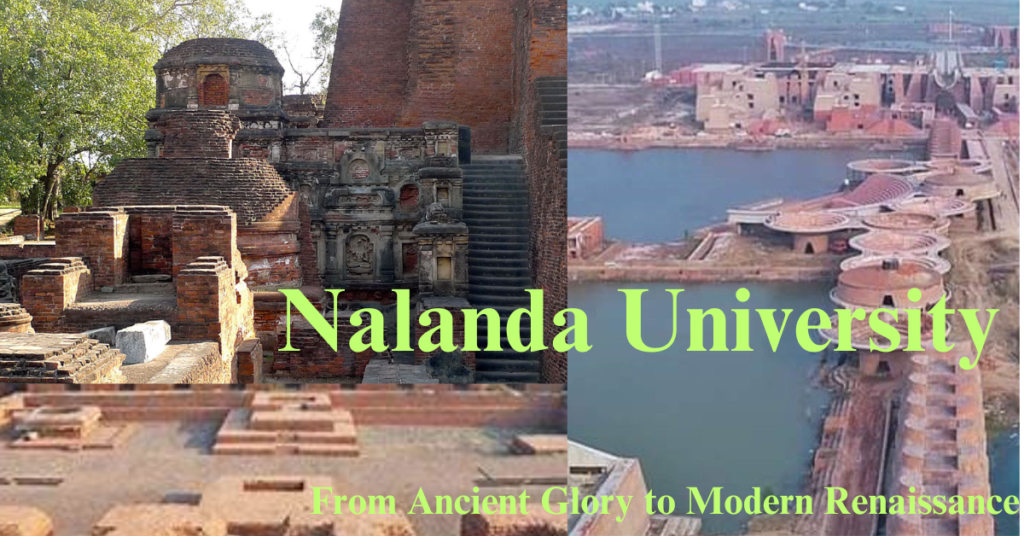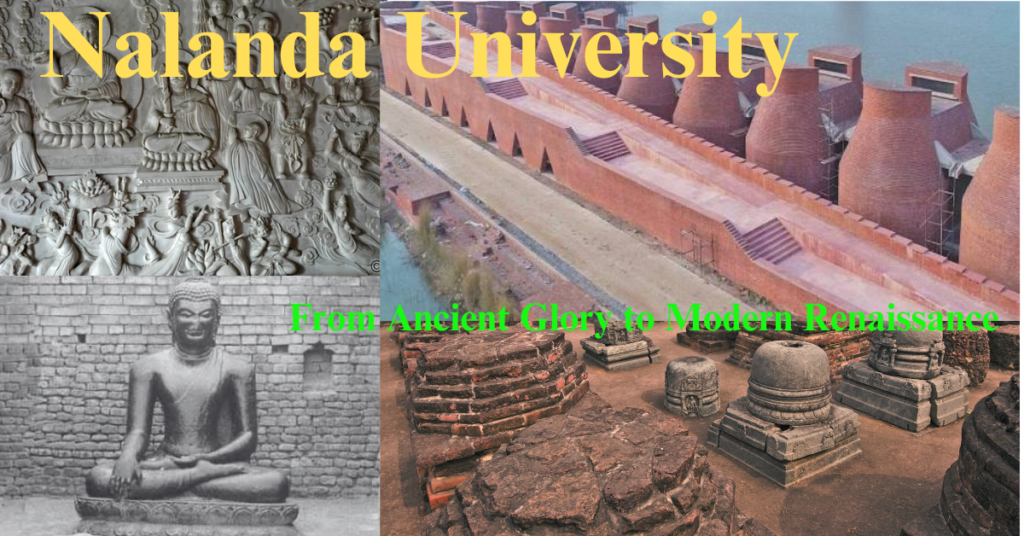
Table of Contents
Nalanda University: From Ancient Glory to Modern Renaissance
Introduction
Nalanda University, situated in the ancient kingdom of Magadha (modern-day Bihar, India), was a beacon of knowledge and a center for Buddhist learning that attracted scholars from all over Asia. Founded in the 5th century CE, it flourished for centuries before its tragic destruction in the 12th century. This article explores the ancient glory of Nalanda University, its historical significance, and its revival in the modern era as a symbol of India’s enduring commitment to education and scholarship.
The Ancient Glory of Nalanda University

Founding and Historical Context
Nalanda University was established during the reign of Kumaragupta I of the Gupta Dynasty in the early 5th century CE. This period, known as the Gupta Era, is often regarded as the golden age of Indian culture, science, and intellectual pursuit. The university quickly became a renowned center for higher learning, drawing students and scholars from across Asia.
The university was not just a local institution but an international hub of knowledge. It embodied the spirit of global exchange and collaboration, much ahead of its time. The Buddhist monastic university served as a place where diverse ideas and philosophies could be studied and debated, contributing significantly to various fields of knowledge.
Academic Excellence and Curriculum
Nalanda University offered a broad curriculum that included Buddhist studies, logic, grammar, medicine, mathematics, astronomy, and the arts. The rigorous academic environment was designed to promote intellectual growth and critical thinking. The university’s pedagogy was rooted in the principles of discussion and debate, which encouraged students to question, analyze, and innovate.
The teaching methodology at Nalanda was based on the ancient Indian tradition of oral discourse, supplemented by extensive written records. The university housed an immense library, known as Dharmaganja, which contained countless manuscripts on a wide range of subjects. This library was divided into three main buildings: Ratnasagara (Ocean of Jewels), Ratnadadhi (Sea of Jewels), and Ratnaranjaka (Jewel-adorned). These buildings housed extensive collections of texts that were meticulously maintained by dedicated librarians.
Architectural and Cultural Significance
The campus of Nalanda University was an architectural marvel, reflecting the advanced planning and construction techniques of the time. It consisted of numerous stupas, temples, monasteries, and lecture halls, all surrounded by lush gardens and serene water bodies. The main stupa, constructed in honor of the Buddha, was a towering structure that symbolized the university’s spiritual and academic mission.
The layout of the university was designed to create an environment conducive to learning and meditation. Residential quarters for students and faculty were well-organized, providing a supportive community for scholarly pursuits. The cultural life at Nalanda was vibrant, with regular events such as debates, lectures, and performances that enriched the intellectual atmosphere.
Destruction and Decline
The prosperity of Nalanda University came to a tragic end in the 12th century when it was destroyed by an climbing army led by Bakhtiyar Khilji, a general of the Delhi Sultanate. The invasion resulted in the burning of the university’s magnificent library and the massacre of many scholars. This devastating event marked the end of Nalanda’s era of intellectual prominence.
For centuries, the ruins of Nalanda lay abandoned, a poignant reminder of a once-great institution that had significantly contributed to global knowledge and culture. The legacy of Nalanda, however, continued to inspire scholars and historians who recognized its importance in the history of education.
Rediscovery and Revival
Archaeological Excavations
The rediscovery of Nalanda began in the 19th century, during the British colonial period, when the field of archaeology started to develop in India. Systematic excavations conducted by the Archaeological Survey of India (ASI) in the early 20th century uncovered the extensive ruins of the ancient university. These excavations revealed the layout of the campus, including the remains of stupas, monasteries, lecture halls, and residential quarters.
Artifacts recovered from the site, such as inscriptions, sculptures, and manuscripts, provided valuable insights into the academic and cultural life at Nalanda. These findings confirmed the historical accounts of the university’s grandeur and its role as a center of learning.
The Modern Nalanda University
Inspired by the rich heritage of ancient Nalanda, the idea of reviving the university gained momentum in the early 21st century. In 2010, the Government of India enacted the Nalanda University Act, which laid the foundation for establishing a new university on the principles of its ancient predecessor.
The modern Nalanda University aims to be a global institution of higher learning, embodying the spirit of intellectual exchange and collaboration that defined the ancient university. Located near the original site, the new university seeks to integrate the historical significance of Nalanda with contemporary educational needs.
Academic and Cultural Impact
Contributions of Ancient Nalanda
The ancient Nalanda University made significant contributions to various fields of knowledge, many of which had a lasting impact on the world. In the realm of Buddhist studies, Nalanda was a leading center for the development and dissemination of Buddhist philosophy and practice. Scholars from Nalanda traveled extensively, spreading Buddhist teachings to regions such as China, Tibet, Korea, and Japan.
In mathematics, Nalanda scholars made important advances in algebra, arithmetic, and geometry. Their works influenced mathematical thought in both the Indian subcontinent and beyond. In the field of medicine, Nalanda produced extensive treatises on herbal remedies, surgical techniques, and the anatomy of the human body. The university’s astronomers made precise calculations of celestial movements and developed sophisticated instruments for astronomical observations.
Vision and Mission of the Modern University
The modern Nalanda University seeks to carry forward the legacy of its ancient predecessor by promoting interdisciplinary and cross-cultural studies. The university offers programs in various fields, including historical studies, ecology and environment studies, Buddhist studies, philosophy, and comparative religions. These programs are designed to address contemporary global challenges while drawing on the wisdom of ancient traditions.
One of the key missions of the new Nalanda University is to foster a global academic community. The university aims to attract students and faculty from around the world, creating an environment where diverse perspectives can thrive. By promoting academic freedom, innovation, and intercultural dialogue, Nalanda University aspires to contribute meaningfully to global knowledge and understanding.
Challenges and Opportunities
Preserving Heritage While Embracing Modernity
One of the significant challenges in reviving Nalanda University has been balancing the preservation of its ancient heritage with the establishment of a modern institution. The ruins of the ancient university are a UNESCO World Heritage Site, and efforts have been made to protect and conserve these historical treasures. This requires careful planning and sensitivity to cultural heritage, ensuring that the new university respects and honors the legacy of its predecessor.
At the same time, the modern university must embrace contemporary educational practices and technologies to meet the needs of today’s students. This involves creating state-of-the-art facilities, fostering innovative teaching methods, and promoting research that addresses current global issues.
Building a Global Institution
To fulfill its vision of becoming a global institution, Nalanda University must attract students, faculty, and researchers from diverse backgrounds. Achieving this requires creating an inclusive and welcoming environment that supports academic excellence and intercultural understanding. The university has been actively building partnerships and collaborations with international institutions, enhancing its global reach and reputation.
Financial sustainability is another critical aspect of building a world-class institution. The university relies on support from governments, private donors, and international organizations to fund its programs and initiatives. Ensuring long-term financial stability is essential for the university to achieve its mission and goals.
Addressing Contemporary Issues
In line with its ancient predecessor, the modern Nalanda University aims to address contemporary global challenges through education and research. This involves focusing on sustainable development, environmental conservation, intercultural understanding, and peacebuilding. By integrating traditional wisdom with modern knowledge, the university aspires to contribute solutions to some of the pressing issues facing humanity today.
The university’s programs are designed to fitup students with the skills and knowledge needed to tackle these challenges. Through interdisciplinary studies, practical training, and collaborative research, Nalanda University prepares its graduates to become leaders and change-makers in their respective fields.
Conclusion
Nalanda University, with its ancient legacy and modern revival, stands as a symbol of India’s enduring commitment to education and knowledge. The ancient university’s contributions to global scholarship and culture continue to inspire generations of learners and educators. The modern Nalanda University, by embracing the principles of academic excellence, inclusivity, and global collaboration, aims to recreate the spirit of its predecessor and become a beacon of knowledge for the future.
As Nalanda University moves forward, it carries with it the weight of history and the promise of the future. By drawing lessons from its past and embracing the opportunities of the present, Nalanda University can once again become a center of learning that enlightens and enriches the world. The journey from ancient glory to modern renaissance is not just a story of revival but a testament to the enduring power of knowledge and the timeless quest for understanding.


